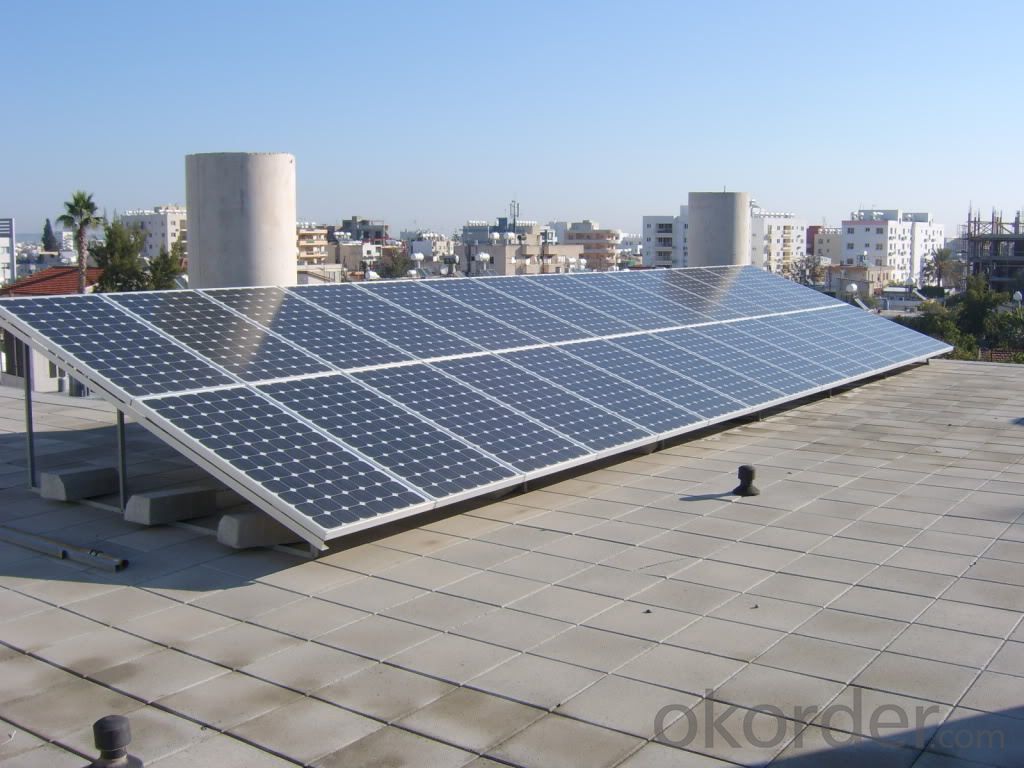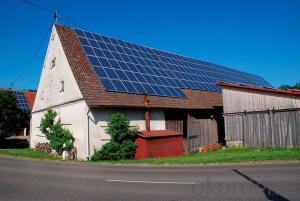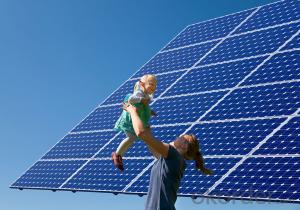CNBM Solar Monocrystalline 156 Series (20W)
- Loading Port:
- China main port
- Payment Terms:
- TT OR LC
- Min Order Qty:
- 100000 watt
- Supply Capability:
- 10000000 watt/month
OKorder Service Pledge
OKorder Financial Service
You Might Also Like
About us
CNBM International Corp, established in 2004, is the business entity for trade and logistic of CNBM Group.With the advantages in Cement, Composite Materials, New Building Materials and Engineering, CNBM mainly concentrate on coal, steel and construction equipments and give priority to solar and wind energy development.CNBM International is highly recognized by its business partners and clients all over the world and has established good business relationship with the customers in over 120 countries and regions all over the world.

Data sheet
| Characteristics | |
| Max Power Voltage Vmp (V) | 17.2V |
| Max Power Current Imp (A) | 1.17A |
| Open Circuit Voltage Voc (V) | 22.2V |
| Short Circuit Current Isc (A) | 1.24A |
| Max Power Pm (W) | 20W |
| Temperature Coefficient of Cells | |
| NOCT | 47℃±2℃ |
| Temperature Coefficients of Isc (%/℃) | 0.06% |
| Temperature Coefficients of Voc (%/℃) | -0.32% |
| Temperature Coefficients of Pmp (%/℃) | -0.45% |
| Mechanical Data | |
| Type of Cells (mm) | Mono156×22.3 |
| Dimension | 490×350×25mm |
| Weight | 2kg |
| NO.of Cells and Connections | 2×8=16 |
| Limits | |
| Operating Temperature | –45°C to +80°C |
| Storage Temperature | –45°C to +80°C |
| Max System Voltage | 700V |
FAQ:
Q1: Why buy Materials & Equipment from OKorder.com?
A: All products offered byOKorder.com are carefully selected from China's most reliable manufacturing enterprises. Through its ISO certifications, OKorder.com adheres to the highest standards and a commitment to supply chain safety and customer satisfaction.
Q2: What is a solar PV module?
A: A solar PV module consists of many solar cells that are connected together (typically in series) and packaged in a frame (typically made of aluminum).
Q3: What are the advantages and disadvantages of monocrystalline solar PV modules?
A: Monocrystalline solar PV modules are the most efficient type of solar PV modules, with the exception of CdTe thin film solar PV modules. As a result, monocrystalline solar PV modules are more expensive when compared to almost all other types of solar PV modules.
Q4: What is the typical service life of a solar PV module?
A: The typical life of a PV module is 25 years. However, superior quality PV modules boast service lives up to 35-40 years (electrical generating capacity is often reduced, however by that point).
Q5: What certifications do you have?
A: We are specialized in the photovoltaic field, with a focus on solar cells, modules and photovoltaic power generation systems. We employ advanced monocrystalline and polycrystalline silicon solar cell manufacturing equipment, producing highly efficient and reliable products sold in Europe, the Americas and Australia. Our company has passed ISO9001 quality management system certification, and our products have obtained TUV-IEC, CE and ISO certification.
Q6: How do we guarantee the quality of our products?
A: We have established an advanced quality management system which conducts strict quality tests at every step, from raw materials to the final product. At the same time, we provide extensive follow-up service assurances as required.
Q7: How long can we receive the product after purchase?
A: Within three days of placing an order, we will begin production. The specific shipping date is dependent upon international and government factors, but is typically 7 to 10 workdays.
- Q:How do solar panels affect the aesthetics of a building?
- Solar panels can have both positive and negative effects on the aesthetics of a building. On one hand, well-designed and integrated solar panels can enhance the visual appeal of a structure by adding a sleek and modern touch. They can be seamlessly incorporated into the architecture, becoming an attractive feature. On the other hand, if poorly installed or placed without careful consideration, solar panels can disrupt the overall design or appear as an eyesore. Therefore, the impact of solar panels on a building's aesthetics largely depends on the design, placement, and integration of the panels into the existing structure.
- Q:i hav e a project for school we need to calculate cost to buy and install solar panels in our school
- Photovoltaic panels have almost zero recurring operating cost. Once installed, they are good for the next 20-25 years, typically. The exceptions are if the panels are not tilted, then you need to pay someone a few times a year to go up there with a mop to clean them. Otherwise, rain and morning dew make the dirt slide off automatically. The cost for your system will depend on the power needs of your school. It also depends on your location. As a government entity, a school is not eligible for the current 30% federal incentive, but may be for state incentives, depending on where you live. Anyway, once you size your system, which will be large, figure on $7 / watt cost for a large system. This would be less if you live in a state with good incentives. So for example, if you needed a 00 kW system, the price would be $700,000. $00,000 of that money is to replace the inverters that break after 5 years, so you would be paying $600,000 up front.
- Q:Can solar panels be used in areas with high levels of radiofrequency interference?
- Yes, solar panels can be used in areas with high levels of radiofrequency interference. However, it is important to ensure proper grounding and shielding measures are in place to minimize the impact of radiofrequency interference on the performance of the solar panels.
- Q:Can solar panels be installed on asphalt shingles?
- Yes, solar panels can be installed on asphalt shingles. However, it is important to ensure that the shingles are in good condition and can support the weight of the panels. Proper installation techniques and mounting systems designed for asphalt shingles should be used to prevent any damage to the roof.
- Q:I remember hearing somewhere that solar panels may attract light rays away from plants thus having a potentially negative effect on the plants. I can't remember where I heard it but I'm curious if there is any truth to it.
- not so. the sun shines on the earth and everything on it. the solar panels are on the earth like on top of your house maybe.if they were not sitting on top of your house , the sun would still be shining on your roof. it makes no sense to say they were drawing light away from other plainest when the sun would still shine on the place where they are if they were not there.
- Q:Can solar panels be used in areas with high levels of vandalism?
- Yes, solar panels can be used in areas with high levels of vandalism. However, it is important to implement additional security measures, such as installing anti-vandalism devices, using tamper-proof mounting systems, and employing surveillance systems to deter potential vandals. Regular maintenance and quick repairs are also crucial to ensure the optimal functioning of solar panels in such areas.
- Q:Can solar panels be installed on a gas station or fueling facility?
- Yes, solar panels can be installed on a gas station or fueling facility. In fact, many gas stations and fueling facilities have started installing solar panels to generate renewable energy to power their operations. This not only helps reduce their carbon footprint but also cuts down on electricity costs.
- Q:I have an inverter and a battery 20 Amperes.Daily sun shine approx. 7 Hours.Do I need to buy anything or should I connect the solar panel to the Battery direct?
- connect the solar panel to the Battery direct during the day time that's how it works in ALL situations !
- Q:What is the lifespan of a solar panel?
- The average lifespan of a solar panel is around 25 to 30 years.
1. Manufacturer Overview |
|
|---|---|
| Location | |
| Year Established | |
| Annual Output Value | |
| Main Markets | |
| Company Certifications | |
2. Manufacturer Certificates |
|
|---|---|
| a) Certification Name | |
| Range | |
| Reference | |
| Validity Period | |
3. Manufacturer Capability |
|
|---|---|
| a)Trade Capacity | |
| Nearest Port | |
| Export Percentage | |
| No.of Employees in Trade Department | |
| Language Spoken: | |
| b)Factory Information | |
| Factory Size: | |
| No. of Production Lines | |
| Contract Manufacturing | |
| Product Price Range | |
Send your message to us
CNBM Solar Monocrystalline 156 Series (20W)
- Loading Port:
- China main port
- Payment Terms:
- TT OR LC
- Min Order Qty:
- 100000 watt
- Supply Capability:
- 10000000 watt/month
OKorder Service Pledge
OKorder Financial Service
Similar products
New products
Hot products
Related keywords






























